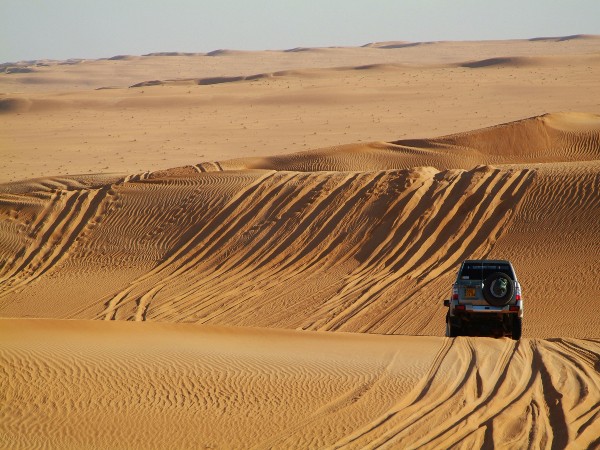Land so bereft of spirit that it has been dubbed the 'desert within the desert'. Rolling waves of dunes, some as lofty as 790ft (241m), touch the horizon and lead to still more dunes in an eternal progression.
But in the desert 'Sahara' as a whole, there is more to this quiet location than just sand. In a spot the size of Spain, there are also shingle-covered plateaus carried by the desert breeze, and incredible rock formations described by one traveller as ogres, goblins and demons.
On the eastern boundary of the Tenere, the oasis townlet of Bilma is the starting point for the camel marches of the Tuareg that trek for 340 miles (545km) across the desert carrying the salt to barter in Agadez. Bilma has offered its title to the Grand Erg of Bilma - a vast stretch of sand spreading eastwards for 740 miles (1184km) from Niger into Chad.

The Erg's southern half consists of self dunes - massive parallel sand cliffs - as much as 90 miles (144km) long and 900 yards (1km) wide. The trenches between the dunes are known as Cassis and are used as courses by caravan merchants.
The wandering Tuareg who treks this hostile environment is known as the 'Men in blue', the Tuareg men conceal their faces, unlike other Muslims. A tradition that may have developed as protection against daylights spent on camel back in the burning Sahara sun and current. The blue hue of the cloth wraps their faces and heads off on their skin - hence their alias.
Salt Of The Earth

The Tuareg's origin of salt lies near Bilma, where intrinsically occurring salt residues disband out of the earth when specially unearthed pits are loaded with water, gravels of salt crystals begin to develop on the water's exterior; they are grazed off and shaped in a rigid mould into cones that weigh about 20lb (9kg). For the trip across the desert, the Tuareg pack the rock-hard cones onto the traversing camels, each creature moving about six blocks.
A march of camels strung jointly nose to tail traverse off across the burning Tenere at a Steady walking rate, and travel for 12 to 16 hours a day without quitting. Milestones are few, and one, a lonely acacia known as the 'Tenere tree', was the lone tree that wanderers might see for several daylights until it was mysteriously obliterated in 1972. It directed them to one of the course's few wells, where much-needed water can be discovered for the next leg of the desert voyage.
It takes 14 days or more of onerous travel to reach Agadez, a seat of commerce and business and the location of a massive camel market in the Mountains. But camel caravans with blue-veiled drivers are a thing of the past, for present Tuareg are using four-wheel-drive SUVs or vehicles, avoiding the trek across the desert for a couple of days.


In distinction to the arid desert, the Mountains, which connect the north-western edge of the Tenere are far from being universally bereft. Near Mount Bagzane some springs allow farmers to grow olives, dates and other crops on hillside terraces.
The mountains, which rise to 6300ft (1917m), are rich in wilderness, with ostriches, gazelles, antelopes and baboons among the bigger species. Earlier residents of the Air mountains have left their impact in the shape of rock art, paintings and carvings, some of which may be 4500 years old. Drawings of rhinoceroses, elephants, and giraffes indicate that the central Sahara once nourished grassy routes for its trade processions, rather than scorching sands.



 Click it and Unblock the Notifications
Click it and Unblock the Notifications






















